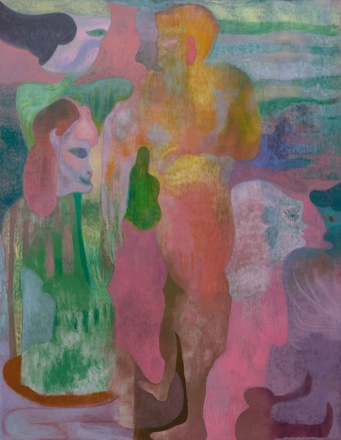Maja Ruznic
Sea People (2024)
Maja Ruznic’s figures are both primal and transient. In a painterly process characterized by the manifold layering of color and abstract forms, the artist unearths archetypical subjects – psychoanalysis has named them father, mother, and child – that sink back into the depth of the composition as soon as we take our eyes off them. In “Sea People,” Ruznic’s first edition for TEXTE ZUR KUNST, green and blue hues accentuate the plane, the heaving sea, and a fleeting horizon. Vertically, faces, limbs, and other diffusely figurative elements are set off in fleshy pastels against the underwater backdrop. Whereas in a classical seascape, the sun would rise or set, here, a broad-shouldered male figure dominates the painting’s radiant yellow center. The amoeba-like form between his legs might be a phallus, just as to the left a fetus might be pushing out of a naked woman’s body.Transformation and fluidity, but also psychological and political abysses, can be associated with the opaque depth of the sea, which is not only a romantic ideal and site of interspecies encounters but also, and critically, a scene of migration. As a child, Ruznic fled with her mother from the war in the former Yugoslavia; she now lives in the US state of New Mexico. The primordial landscape there, as well as the experience of becoming a parent, influenced her most recent series of works, which was recently shown at the solo exhibition “Mutter” at CFA Berlin and included this image. In Ruznic’s painting, references to Marc Chagall, Gustav Klimt, and Edvard Munch push their way to the surface, only to fade again into surges of color.

